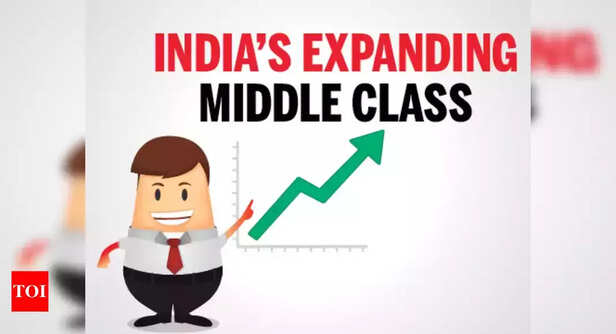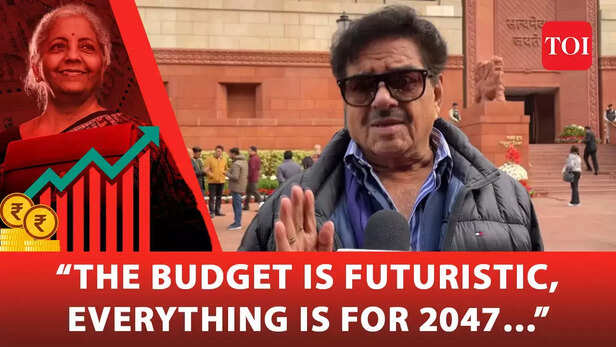The Forgotten Backbone: Middle-Class Tax Relief Gains Momentum Ahead of Budget 2025
Nidhi | Jan 13, 2025, 23:05 IST
The Indian middle class, often hailed as the nation's backbone, continues to grapple with disproportionate tax burdens and underrepresentation in policy-making. Despite contributing significantly to the country’s GDP and driving consumer demand, this demographic faces thankless challenges in their quest for economic stability. This article explores the struggles of the middle class, highlights their economic contributions, and examines how tax relief measures could unlock their potential to further boost India’s growth.
As the countdown to Budget 2025 begins, the spotlight is turning toward India’s middle class, a demographic often hailed as the backbone of the nation yet frequently overlooked in policy discussions. A tweet that has recently gone viral encapsulates the plight and patriotism of this crucial segment of society: “If you really look at it, alongside soldiers, doctors, and teachers, the real Nationalists are the middle-class Indians between the ages of 20 and 45, who have stayed back in India… because most of them genuinely wanted to contribute to our country’s progress.”
This poignant sentiment is not merely rhetoric. It underscores a deep frustration borne out of years of being overburdened and underappreciated. The middle class, constituting approximately 31% of India’s population, has long been the engine driving economic growth. Yet, their contributions remain largely invisible in national conversations. With mounting calls for tax relief, Budget 2025 presents a critical opportunity to acknowledge and alleviate their struggles.

India’s middle class is a vast and diverse group, typically defined by annual household incomes between ₹5 lakh and ₹30 lakh. This segment is projected to grow to 38% of the population by 2031, cementing its role as a cornerstone of the Indian economy. Yet, this growth has not translated into equitable recognition or relief.
One of the primary challenges faced by this demographic is the disproportionate tax burden. Individuals earning between ₹10 lakh and ₹15 lakh annually have an average tax liability of ₹1.1 lakh. Additionally, the Goods and Services Tax (GST), a significant indirect tax, disproportionately impacts middle-class households by increasing the cost of essential goods and services. Despite these contributions, there has been little to no significant relief for this segment in recent budgets.
The middle class plays a pivotal role in India’s economic narrative. Their spending drives demand across sectors like consumer goods, real estate, and technology. Middle-class households are among the largest consumers of education and healthcare services, thereby indirectly fostering employment and investment in these sectors.
Moreover, the middle class is a significant contributor to the nation’s tax revenue. While individuals earning above ₹50 lakh contribute 76% of income tax collections, the middle class’s collective contributions through direct and indirect taxes are equally critical. Their tax payments help fund infrastructure projects, social welfare programs, and other government initiatives.

The middle class’s struggles are further exacerbated by rising living costs. Inflation, particularly in essential goods like food and fuel, has eroded disposable incomes. For instance, food inflation in 2024 surged to a decade-high of over 11%, tightening household budgets even further.
Education and healthcare costs, two areas where middle-class families prioritize spending, have also seen steep increases. The cost of private school education has risen by 10-12% annually, while healthcare expenses, especially post-pandemic, have become a significant financial burden. These escalating costs, coupled with stagnant income growth, have left many middle-class families in a precarious financial position.
The growing demand for tax relief is not merely about financial convenience; it’s about equity and survival. Experts and industry leaders have proposed several measures to ease the burden on the middle class:
The middle class’s contributions go beyond economic metrics. They are the educators, healthcare workers, engineers, and entrepreneurs who sustain India’s growth and development. Yet, their efforts often go unrecognized, overshadowed by discussions focused on poverty alleviation or wealth generation.
This lack of recognition has led to a growing sense of alienation. As one social media user aptly put it, “The middle class is the thankless backbone of the nation. They don’t register in our national consciousness because they’re neither poor enough to evoke sympathy nor rich enough to wield influence.”

Budget 2025 offers a unique opportunity for policymakers to address these longstanding grievances. By implementing thoughtful tax reforms, the government can provide much-needed relief to the middle class, ensuring their continued contribution to India’s progress.
Additionally, recognizing the middle class as a vital stakeholder in national development could foster a sense of inclusion and appreciation. Public acknowledgment of their sacrifices and contributions—through policies, incentives, or even symbolic gestures—could go a long way in boosting morale and trust in governance.
The middle class is often described as the backbone of India, and rightly so. Their resilience, hard work, and unwavering commitment to the nation’s progress are unparalleled. Yet, they remain one of the most underappreciated demographics in the country.
As the government prepares to unveil Budget 2025, it must seize the opportunity to address the needs and aspirations of this silent majority. Tax relief and policy recognition are not merely acts of generosity; they are investments in the very foundation of India’s future.
It’s time to move beyond rhetoric and deliver tangible benefits to the forgotten backbone of our nation. For without a strong and supported middle class, the dream of a prosperous India remains incomplete.
This poignant sentiment is not merely rhetoric. It underscores a deep frustration borne out of years of being overburdened and underappreciated. The middle class, constituting approximately 31% of India’s population, has long been the engine driving economic growth. Yet, their contributions remain largely invisible in national conversations. With mounting calls for tax relief, Budget 2025 presents a critical opportunity to acknowledge and alleviate their struggles.
The Middle-Class Conundrum

Finance Minister: Nirmala Sitharaman
India’s middle class is a vast and diverse group, typically defined by annual household incomes between ₹5 lakh and ₹30 lakh. This segment is projected to grow to 38% of the population by 2031, cementing its role as a cornerstone of the Indian economy. Yet, this growth has not translated into equitable recognition or relief.
One of the primary challenges faced by this demographic is the disproportionate tax burden. Individuals earning between ₹10 lakh and ₹15 lakh annually have an average tax liability of ₹1.1 lakh. Additionally, the Goods and Services Tax (GST), a significant indirect tax, disproportionately impacts middle-class households by increasing the cost of essential goods and services. Despite these contributions, there has been little to no significant relief for this segment in recent budgets.
Economic Contributions of the Middle Class
Moreover, the middle class is a significant contributor to the nation’s tax revenue. While individuals earning above ₹50 lakh contribute 76% of income tax collections, the middle class’s collective contributions through direct and indirect taxes are equally critical. Their tax payments help fund infrastructure projects, social welfare programs, and other government initiatives.
The Strain of Rising Costs

India’s middle class is expanding
The middle class’s struggles are further exacerbated by rising living costs. Inflation, particularly in essential goods like food and fuel, has eroded disposable incomes. For instance, food inflation in 2024 surged to a decade-high of over 11%, tightening household budgets even further.
Education and healthcare costs, two areas where middle-class families prioritize spending, have also seen steep increases. The cost of private school education has risen by 10-12% annually, while healthcare expenses, especially post-pandemic, have become a significant financial burden. These escalating costs, coupled with stagnant income growth, have left many middle-class families in a precarious financial position.
Calls for Tax Reforms
- Revised Tax Slabs: Former Infosys CFO Mohandas Pai has suggested updated tax slabs, such as no tax for incomes up to ₹5 lakh, 10% for ₹5-₹10 lakh, 20% for ₹10-₹20 lakh, and 30% for incomes above ₹20 lakh. This restructuring would align tax obligations with current income levels and inflation.
- Marginal Tax Relief: Sanjiv Puri, President of the Confederation of Indian Industry (CII), has recommended tax relief for individuals earning up to ₹20 lakh annually. According to Puri, “From the perspective of boosting consumption, we have proposed relief in the marginal tax rate, which would increase disposable income and lead to buoyancy in revenues.”
- Broadening the Tax Base: Finance influencers like Akshat Shrivastava have argued for widening the tax base to reduce the burden on existing taxpayers. He suggests that lowering tax rates could stimulate economic activity by increasing disposable income and encouraging spending.
- Addressing GST Burden: Reducing GST rates on essential goods and services could provide immediate relief to middle-class families, enabling them to save or invest more effectively.
The Case for Recognition
This lack of recognition has led to a growing sense of alienation. As one social media user aptly put it, “The middle class is the thankless backbone of the nation. They don’t register in our national consciousness because they’re neither poor enough to evoke sympathy nor rich enough to wield influence.”
The Road Ahead

Budget 2024
Budget 2025 offers a unique opportunity for policymakers to address these longstanding grievances. By implementing thoughtful tax reforms, the government can provide much-needed relief to the middle class, ensuring their continued contribution to India’s progress.
Additionally, recognizing the middle class as a vital stakeholder in national development could foster a sense of inclusion and appreciation. Public acknowledgment of their sacrifices and contributions—through policies, incentives, or even symbolic gestures—could go a long way in boosting morale and trust in governance.
As the government prepares to unveil Budget 2025, it must seize the opportunity to address the needs and aspirations of this silent majority. Tax relief and policy recognition are not merely acts of generosity; they are investments in the very foundation of India’s future.
It’s time to move beyond rhetoric and deliver tangible benefits to the forgotten backbone of our nation. For without a strong and supported middle class, the dream of a prosperous India remains incomplete.
